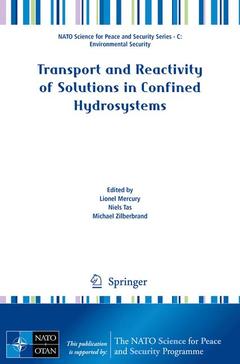Description
Transport and Reactivity of Solutions in Confined Hydrosystems, 2014
NATO Science for Peace and Security Series C: Environmental Security Series
Coordinators: Mercury Lionel, Tas Niels, Zilberbrand Michael
Language: English
Subjects for Transport and Reactivity of Solutions in Confined...:
Publication date: 12-2013
268 p. · 15.5x23.5 cm · Paperback
Publication date: 12-2013
268 p. · 15.5x23.5 cm · Hardback
Description
/li>Contents
/li>Comment
/li>
The present work reflects a multi-disciplinary effort to address the topic of confined hydrosystems developed with a cross-fertilization panel of physics, chemists, biologists, soil and earth scientists. Confined hydrosystems include all situations in natural settings wherein the extent of the liquid phase is limited so that the solid-liquid and/or liquid-air interfaces may be critical to the properties of the whole system. Primarily, this so-called ?residual? solution is occluded in pores/channels in such a way that decreases its tendency to evaporation, and makes it long-lasting in arid (Earth deserts) and hyper-arid (Mars soils) areas. The associated physics is available from domains like capillarity, adsorption and wetting, and surface forces. However, many processes are still to understand due to the close relationship between local structure and matter properties, the subtle interplay between the host and the guest, the complex intermingling among static reactivity and migration pathway.
Expert contributors from Israel, Russia, Europe and US discuss the behaviour of water and aqueous solutes at different scale, from the nanometric range of carbon nanotubes and nanofluidics to the regional scale of aquifers reactive flow in sedimentary basins. This scientific scope allowed the group of participants with very different background to tackle the confinement topic at different scales. The book is organized according to four sections that include: i) flow, from nano- to mega-scale; ii) ions, hydration and transport; iii) in-pores/channels cavitation; iv) crystallization under confinement. Most of contributions relates to experimental works at different resolution, interpreted through classic thermodynamics and intermolecular forces. Simulation techniques are used to explore the atomic scale of interfaces and the migration in the thinnest angstrom-wide channels.
Confined water in complex networks: unifying our understanding of pore water and solutes at all scales; L. Mercury et al.- Interactions in water across interfaces: from nano to macro-scale perspective; R. M. Espinosa-Marzal.- Theme 1: Flow, from nano- to mega-scale; J. Eijkel.-Confined water in carbon nanotubes and its applications; S.K. Youn et al.- Static and dynamic capillarity in silicon based nanochannels; N. Tas et al.- Confined water in saturated and non-saturated media: Infrared signature and thermodynamic properties; I. Bergonzi, L. Mercury.- Interchange of Infiltrating and Resident Water in Partially Saturated Media; B. Berkowitz.- Impact of heterogeneity on evaporation from bare soils; S. Assouline et al.- Theme 2: Ions, Hydration and Transport; R. Karnik.- Enhanced Ion Transport in 2-nm Silica Nanochannels; C. Duan.- Ionic and Molecular Transport through Graphene Membranes; R. Karnik.- Molecular structure and dynamics of molecular water: computer simulations of aqueous species in clay, cement, and polymer membranes; A.G. Kalinichev.- Two generalizations of the theory of seismoelectric effect: Parameterization providing suitability of Frenkel's theory for any geometry of soil's pore space. The role of thermoosmosis in seismoelectric effect; V.N. Shilov.- Theme 3. In-channels/pores cavitation; A.R. Imre, J.S. Sperry.- Evaporation-Induced Cavitation in Nanofluidic channels: Dynamics and Origin; C. Duan.- Electrocavitation in nanochannels; D.S. van Schoot et al.- Stability and negative pressure in bulk and confined liquids; A.R. Imre.- Experimental superheating and cavitation of water and solutions at spinodal-like negative pressures; L. Mercury, K.I. Shmulovich.- Plant water transport and cavitation; T. Hölttä, J. Sperry.- Theme 4: Crystallization under confinement; M. Steiger, M. Prat.- Crystal growth and phase equilibria in porous materials; M. Steiger.- Shaping the interface - interactions between confined water and the confining solid; D.K. Dysthe.- Geochemistry of capillary hydrogeochemical systems in arid environments; A. Lassin et al.- Evaporation from a porous medium in the presence of salt crystallization; M. Prat.- Micro-CT analysis to explore salt precipitation impact on porous media permeability; N. Weisbrodet al.- Reactive Transport in Heterogeneous Media; H. Scher , B. Berkowitz.- Extraction of water from the atmosphere in arid areas by employing composites "a salt inside a porous matrix"; L. Gordeeva, Yu. Aristov.
It provides a timely overview of dynamic and static experiments on confined water conducted as a function of the size of pores/channels
It discusses the liquid confinement in pores/channels in a variety of materials, scales and applications: from clean water technology, building material weathering, to environmental prediction
It connects conceptions of confinement from very different branches of science, such as geology, biology, physical chemistry, and nano-physics
These books may interest you

Dynamics in Geometrical Confinement 118.31 €

Dynamics in Geometrical Confinement 137.14 €


